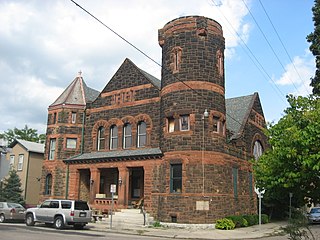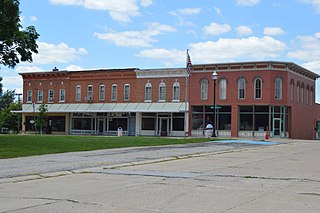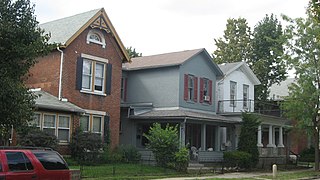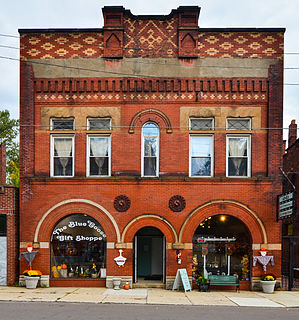
South Park is a 24-block, 150-acre area of more than 780 structures primarily dating from the 1880s to the early twentieth century. It is located south of downtown Dayton, Ohio, just north of the University of Dayton campus and Woodland Cemetery, and east of Miami Valley Hospital. Mainly residential in character, South Park is significant because of the variety of its architecture, which includes vernacular, cottage, and high style examples, and because of its association with John H. Patterson, founder of the National Cash Register Company.

The McPherson Town Historic District of Dayton, Ohio, contains roughly 90 structures north of downtown Dayton, across the Great Miami River.

Saint Anne's Hill Historic District is part of the Historic Inner East neighborhood in Dayton, Ohio, United States. St. Anne's Hill constitutes a grouping of both vernacular and high style Victorian residences which date roughly from 1860 to the early 20th century. Having originally been platted in 1802 by German immigrants, the neighborhood is significant for its German heritage. Stivers School for the Arts is located within St. Anne's Hill.

The Sycamore Historic District is a meandering area encompassing 99 acres (400,000 m2) of the land in and around the downtown of the DeKalb County, Illinois, county seat, Sycamore. The area includes historic buildings and a number of historical and Victorian homes. Some significant structures are among those located within the Historic District including the DeKalb County Courthouse and the Sycamore Public Library. The district has been listed on the National Register of Historic Places since May 2, 1978.

Barry Historic District is a historic district comprising the commercial and older residential areas of Barry, Pike County, Illinois. Barry was founded as an agricultural community in the 1830s, and most of its development took place between its founding and the Civil War. The city's commercial core, however, was mainly built in 1894 after a fire destroyed most of the existing commercial buildings. The 1894 buildings are well-preserved examples of typical commercial architecture of the period, and several have metal storefronts. The district also includes Barry's "Diamond Hill" residential district on Mortimer Street east of Brown Street and several other residential sections. Prominent architectural styles in the residential areas include Italianate, Queen Anne, Carpenter Gothic, and vernacular types from the late 19th century.

The Steele's Hill–Grafton Hill Historic District, or simply known locally as Grafton Hill, is a small 18-block sector of Dayton, Ohio, United States that was developed in the late 19th century.

The Huffman Historic District is a historic neighborhood in eastern Dayton, Ohio, United States. Formed at the end of the nineteenth century primarily by a wealthy businessman, it has long been home to people of many different occupations and numerous places on the social ladder. After seeing very few changes throughout the twentieth century, it was named a historic site in the 1980s.

The Ashtabula Harbour Commercial District is a historic district in the northern section of the city of Ashtabula, Ohio, United States. Comprising a commercial section near the city's Lake Erie waterfront, the district includes buildings constructed largely in the late nineteenth century, at which time Ashtabula was a flourishing port city.

The Central Avenue Historic District is a small segment of the larger Grafton Hill neighborhood of Dayton, Ohio, United States. Composed of just two blocks near the border between Grafton Hill and Dayton View, the historic district comprises a cohesive collection of houses dating primarily from the turn of the 20th century, and it has been named a historic site.

The Kossuth Colony Historic District, named for Lajos Kossuth, is a nationally recognized historic district bounded by Baltimore Street, Mack Avenue and Notre Dame Avenue in Dayton, Ohio. The Kossuth Colony was built in 1906 to house Hungarian immigrant workers for the Barney and Smith Car Company, a rail car manufacturer that ranked among Dayton's largest and most venerable firms. Comparatively few changes have been made to the forty houses in the colony, although the houses' white picket fences have been removed. Many houses in the district are simple gable-front residences with minimal setbacks, and asbestos siding covers many exterior walls in the district.

Glenville Historic District, also known as Sherwood's Bridge, is a 33.9 acres (13.7 ha) historic district in the Glenville neighborhood of the town of Greenwich, Connecticut. It is the "most comprehensive example of a New England mill village within the Town of Greenwich". It "is also historically significant as one of the town's major staging areas of immigrants, predominantly Irish in the 19th century and Polish in the 20th century" and remains "the primary settlement of Poles in the town". Further, "[t]he district is architecturally significant because it contains two elaborate examples of mill construction, designed in the Romanesque Revival and a transitional Stick-style/Queen Anne; an excellent example of a Georgian Revival school; and notable examples of domestic and commercial architecture, including a Queen Anne mansion and an Italianate store building."

There are nine historic districts in Meridian, Mississippi. Each of these districts is listed on the National Register of Historic Places. One district, Meridian Downtown Historic District, is a combination of two older districts, Meridian Urban Center Historic District and Union Station Historic District. Many architectural styles are present in the districts, most from the late 19th century and early 20th century, including Queen Anne, Colonial Revival, Italianate, Art Deco, Late Victorian, and Bungalow.

The Groton Bank Historic District, commonly known as Groton Heights, is a primarily residential 50-acre (20 ha) historic district in the City of Groton in Connecticut. The district was added to the National Register of Historic Places on March 24, 1983.

Middlebourne Historic District is a national historic district located at Middlebourne, Tyler County, West Virginia. It encompasses 88 contributing buildings that include the civic, commercial, and residential core of Middlebourne. Most of the buildings in the district date from the late-19th and early-20th century in popular architectural styles, such as Queen Anne and Classical Revival. The two oldest are the Federal-style Quinif House (1805) and Gorrell-Wetzel House (1807). Other notable buildings include the Tyler County High School (1907), First National Bank (1902), Smith's Drug Store, Nadene Theater, The Powell-Shore House, the Weekley House, the Huth-Fletcher House (1895), and United Methodist Church and Parsonage (1910). Also located in the district is the separately listed Tyler County Courthouse and Jail.

Alderson Historic District is a national historic district located at Alderson, Greenbrier County and Monroe County, West Virginia. The district encompasses 196 contributing buildings and three contributing sites located in the commercial district and surrounding residential section. They are predominantly 19th and early 20th century frame detached residences and masonry commercial buildings including notable examples of the Federal, Greek Revival, and Queen Anne styles. Notable buildings include the Woodson Mohler Grocery building, Johnson and Gwinn warehouse, Greenbrier Mill, First National Bank building, Alderson's Store, Chesapeake and Ohio depot, U.S. Post Office, and the City Hall (1939). The Alderson Ferry Site is for the ferry established 1789. Located in the district is the separately listed Alderson Bridge.

The Laburnum Park Historic District is a national historic district located at Richmond, Virginia. The district encompasses 226 contributing buildings and 2 contributing structures located north of downtown Richmond. The primarily residential area developed starting in the early-20th century as one of the city's early "streetcar suburbs" and as home to several important local institutions. The buildings are in a variety of popular early-20th century architectural styles including Queen Anne and Colonial Revival. It was developed as neighborhood of middle-to-upper-class, single-family dwellings. Notable buildings include the Laburnum House (1908), Richmond Memorial Hospital (1954-1957), Richmond Memorial Hospital Nursing School (1960-1961), "The Hermitage" (1911), Laburnum Court (1919), Veritas School.

Franklin Street Commercial Historic District is a national historic district located at Michigan City, LaPorte County, Indiana. The district encompasses 73 contributing buildings and 1 contributing object in the central business district and surrounding residential section of Michigan City. It developed between about 1875 and 1955, and includes examples of Italianate, Gothic Revival, Queen Anne, Classical Revival, and Tudor Revival style architecture. Located in the district is the separately listed Michigan City Post Office (1909-1910). Other notable buildings include the Staiger House, Earl House, M & M Diner (1955), Zorn Building (1907), St. Paul's Lutheran Church (1876) and rectory (1888), First Federal Savings Bank, Aicher Block (1914), Brinkman Building, Trinity Episcopal Church (1889), Merchants National Bank Building (1926), Ledbetter Building (1908), Rodenbeck Saloon, First Methodist Episcopal Church (1922), Barker Hall (1929), Masonic Temple (1922-1923), and the Salvation Army Building (1925).

The Rockland Residential Historic District encompasses a predominantly residential area west of the downtown of Rockland, Maine. With a history dating to the early 18th century, this area includes high quality examples of residential architecture, most dating to the period 1870-1920, and including several fine examples of municipal architecture. It was listed on the National Register of Historic Places in 1987.

Chillicothe Commercial Historic District is a national historic district located at Chillicothe, Livingston County, Missouri. The district encompasses 24 contributing buildings in the central business district and surrounding residential area of Chillicothe. It developed between about 1889 and 1950, and includes representative examples of Queen Anne, Italianate, Beaux Arts, Mission Revival, and Art Deco style architecture. Notable buildings include the Scruby Brothers Building (1893), S. A. Stone Building, Dairy Creme Building, Strand Coffee Shop Building (1936), Strand Hotel and Garage (1925), Norman & Jarvis Funeral Home Building, Empire Theatre (1916), Chillicothe Post Office/Federal Building (1916), Grace & Simpson Apartments (1916), and Loomis Building/Chillicothe Post Office (1898).

The Sheffield Historic District is a national historic district in the Lincoln Park neighborhood of Chicago, Illinois. The district is primarily a residential area, though it also includes multiple small commercial areas. The area takes its name from Joseph and Maria Sheffield, who established a farm at the site in the late 1830s. Residential development in the area began in 1868, as European immigrants created a demand for new housing, and continued through the 1900s. The district includes examples of many of the most popular architectural styles of the late nineteenth century, with the Queen Anne and Romanesque Revival styles being especially well-represented.

























